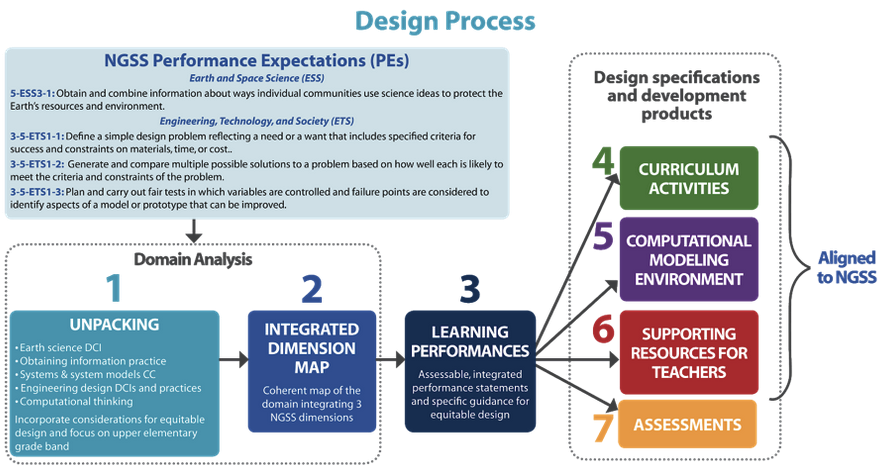The SPICE team uses a principled design approach based on evidence-centered design to ensure that materials are designed equitably for diverse students audiences and aligned to the target NGSS Performance Expectations.
Designing to Integrate Science, Engineering, and Computational Modeling for NGSS

- Unpacking the dimensions entails gathering substantive information about how knowledge and skills are acquired and used in the domain.
- Integrated dimension maps describe essential disciplinary relationships and link them to aspects of the targeted practices and crosscutting concepts.
- Learning performances are three-dimensional performance statements aligned with the PEs that represent intermediate targets for curriculum and assessment design.
- The curriculum unit guides students through an investigation about the cause of urban water runoff, and an engineering challenge to design school ground surfaces in a way that minimizes runoff. Students engage in both hands-on activities and technology-supported inquiry. The learning performances constitute anchors for curriculum sequences.
- Students use a computational modeling environment to develop a water runoff model. Students then use the model to determine how rainfall intensity, rainfall duration, and surface material affect water runoff and test playground designs against design constraints. The block-based programming interface is designed to promote students’ integration of science, engineering, and computational thinking concepts and practices. Custom programming blocks decrease students’ attention to syntax and highlight key scientific concepts that are essential to the model.
- Supporting resources for teachers include multi-day professional development workshops; a detailed teacher guide to support teachers’ classroom implementation; and educative resources about science inquiry, engineering design, computational modeling.
- Assessments embedded within the curriculum and aligned with the learning performances provide evidence of students’ 3-dimensional proficiency. Observation tools help teachers interpret students’ responses to the assessments and inform instructional next steps.
Equitable Design
In parallel with the design process described above, our design approach integrates principles of equity and inclusion (EI) from start to finish.

Promoting equity and inclusion in the design of NGSS-aligned curriculum activities
- First, our framework that articulates the focal EI principles to be integrated into the curriculum design. Our particular framework focuses on the principles of fostering student engagement and providing language supports that make the curriculum more accessible to all students.
- Our domain analysis applies the EI framework in Step 1 to document specific EI challenges that relate to the identified knowledge and skills associated with each dimension and identify engagement and language supports to address those challenges.
- To address EI, our learning performances vary opportunities that students have to build toward broad learning goals by highlighting different skills and experiences. Because learning performances address different aspects of the broad learning goal, appropriate EI
supports may differ from one learning performance to another. Therefore, we align EI design guidelines to the learning performances in order to support the integration of dimensions in a specific learning performance. - Our designers apply the EI design guidelines to ensure that curriculum activities address the needs of diverse students by incorporating specific instructional features and perspectives represented in the guidelines at the onset of design. After the curriculum activities are developed, a review (by the design team and/or an independent expert) ensures that EI guidelines are appropriately incorporated.
- During classroom implementation, we document observations of how teachers and students use the materials and gather critical feedback from teachers and students using surveys and/or interviews. These observations and insights inform subsequent design revisions to improve the materials’ adherence to the core EI principles.